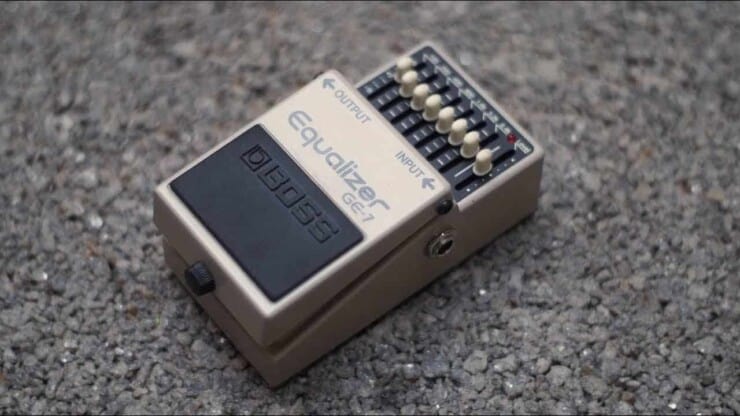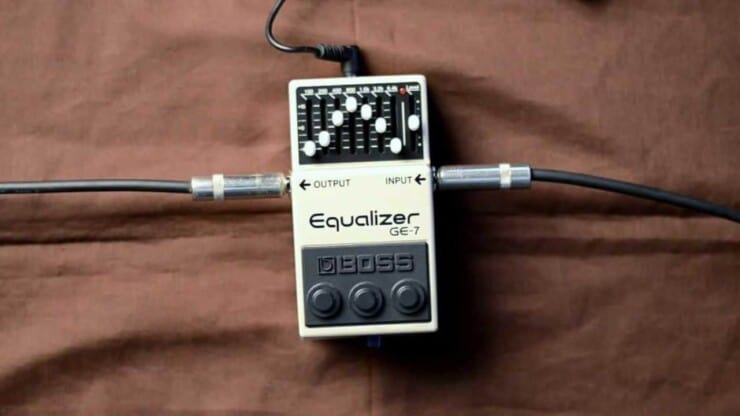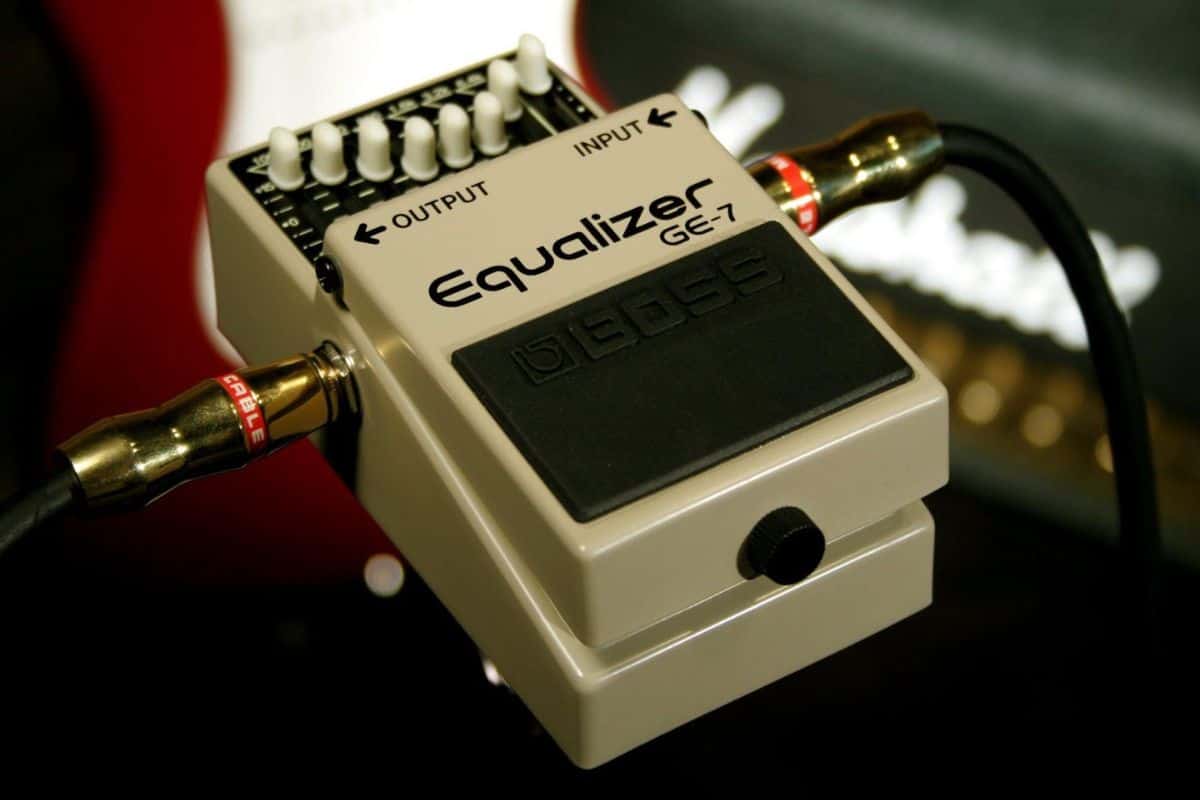Are you new to the world of pedals and guitar rigs and don’t know where to put EQ on pedalboard? Don’t worry, all your doubts will be cleared here.
Putting EQ on pedalboard in the right order is important to get the best sound out of the guitar rig. EQ pedals are usually put in front of the distortion or gain-based effects. Placing the EQ before the amp and in the loop will give you massive tonal options.
In this article, you will get to know all about EQ pedals, what is an EQ pedal, where to put EQ on pedalboard, and creative ways of using EQ on the pedalboard. Continue reading to get all the answers you are looking for.
What is an EQ pedal?
EQ essentially stands for equalization. The audio frequencies that you hear around you sit across a wide spectrum. The human ear can hear sound frequencies between 20Hz and 20kHz. In basic terms, an EQ pedal will allow you to boost (increase) or cut (decrease) the frequencies inherent in the guitar tone. An EQ pedal is widely considered by many guitarists as a utility pedal. Similar to an ABY unit or a noise gate, an EQ pedal is not used for generating an effect like a time-based pedal, but instead, it will serve a more practical purpose.
EQ represents the universal spectrum of sound, and it defines where certain frequencies sit on this spectrum. They are used to boost or cut them through linear filters. This process will allow you to manipulate the audible qualities of sound/instrument, in this case, a guitar. Essentially, EQ pedals are employed as a tone-shaping tool for improving the sound of your rig.
Interestingly, the functionality of the EQ stompbox is broader than you may think. It can also be used in creative and unconventional ways as well.
How does an EQ pedal work?
A compact EQ pedal will allow you to affect guitar-centric frequencies only. Generally, humans can identify frequencies between 20Hz and 20kHz. However, a guitar will typically occupy an area between 80Hz and 10kHz. Even though this is a narrower window, it’s still a relatively wide range. Many EQ pedals will give you total control of frequencies in the specific bandwidth range.
Most examples sport numerous filtering sliders, with each one of them offering direct control of a certain set frequency. Sliders between 80Hz and 250Hz affect the lows. Meanwhile, the 250Hz-800Hz is considered to be the mid-range. This is arguably the most vital part of your guitar’s sound. You’ll reach top-end territory if you go beyond 800Hz, with 5-kHz-10kHz being the most present part of the tone.
Depending on how dramatically you’re moving the sliders, the input signal running EQ pedals will be subject to significant manipulation. There aren’t other types of guitar pedals that change the sound as drastically as an EQ can. This makes it an incredibly powerful device.
Graphic vs. Parametric EQ
An EQ pedal having sliders is known as a Graphic EQ. They usually vary between 5-band (5 sliders) to extremely precise 10-band models. Boss’ 7-band GE-7 Graphic Equalizer Stompbox is a great choice, striking the right balance between simple and sophisticated. The other types of EQ stompboxes are Parametric EQ Stompboxes. These derive closely from traditional mixing desks. They feature knobs as opposed to sliders. Parametric EQ is far more suitable to fastidious tone-chasers. It’ll allow you to sweep the center frequency while helping you find particular sweet spots.
Moreover, Parametric EQ will offer greater control and isn’t as limited as Graphic EQ can be. The Empress ParaEQ is a particularly favored choice, with multiple controls, allowing for excellent signal manipulation.
Where to put EQ on pedalboard?
If you’re looking to know where to put EQ on pedalboard, then the answer is it depends. It’ll depend on what you’re trying to accomplish. Normally, EQ is recommended in front of distortion or gain-based effects, if you’re looking to drive and color the sound. Putting EQ after distortion will give you volume changes that allow you to switch to a louder sound. This isn’t normally possible if the EQ is before distortion.
On the face of it, an EQ pedal might seem a bit redundant. EQ pedals don’t technically make any sound by themselves, and you already have EQ controls on the amp, right? Yes, but when used correctly, an EQ pedal will give you one of the most important weapons in your tonal arsenal. Moreover, it’ll take your guitar’s tone to another level.

Placement will be key when using an EQ pedal, and it can be used in multiple ways. If you’re placing the EQ pedal in front of the amp, it’ll give more of an effect on the response of your amp. This will be similar to turning the volume down on the guitar knob or using different boost pedals. If you’re placing the EQ pedal in the effects loop of the amp, it’ll function like a post-EQ in the studio. This will allow you to tweak and fine-tune the overall tone.
Running an EQ both before the amp and in the loop will give you a lot of tonal changes. With the stereo in/out routing on the EQ, you’ll be able to do just that without requiring separate pedals.
Creative ways of using an EQ pedal in your pedalboard
After understanding what EQ is and where to put EQ on pedalboard, you’ll want to know how to use it. Here are some of the most creative ways you can include an EQ pedal in your pedalboard.
As a versatile booster
High gain amps often have a lot of lows and highs on tap. This means that if you’re running them too hot, the low end could get fuzzy. Meanwhile, the high end might end up being too shrill.
You’ll probably know that one of the most universally used methods of tightening the sound is to run an SD-1 or a TS-type pedal in front of the amp. Moreover, the drive should be set very low and the level set at high. These types of pedals feature a strong midrange hump while slightly pulling back in the bass and treble frequencies. The result will be better note articulation, tighter palm mutes, and enough midrange for punching through the mix.
An EQ pedal can be used in the same way, but with more ability to zero in on the perfect frequencies for complementing your amp.
For instance, the TS Mid-Hump is somewhere in the 600-800Hz region, depending on where you’re setting the tone control. Further, every pedal builder making a TS-variant will have a secret spot where they place the frequency center. This gives each variant a different flavor of boost. Using an EQ, you’ll be able to dial in the classic mid-hum by boosting the 800Hz slider. All this while pulling back on the bass and treble frequencies.
If the bass is still flabby, you can dial a bit more out of the signal. If you want a bit more of the singing upper mids, you can easily choose to center the hump near the 1.6kHz band mark. This will be outside the capabilities of most EQ pedals. Bump the level slightly to naturally drive the front end of the amp, and you’ll get a killer high-gain tone. It’ll be easy to see how this concept will be extended to imitate any type of boost pedal. You can flatten the mids to get a more transparent style. You can also accentuate the highs, and it’ll act as a trouble booster.
Ultimately, an EQ pedal will act as a more precise, configurable, and versatile boost pedal.
For adding an extra channel to the amp
If you have a non-master volume amp, chances are that you’ll love the tone of the amp. It’ll be even better when it’s cranked and the power section in the am is cooking. However, the compromise you’re making by using a classic amp design is that you don’t have a clean channel. Rolling back the guitar volume will get you halfway there. But in general, you won’t be able to attain the sparkling clean tone that most people desire. That is unless you’ve got a high-quality EQ pedal. In such scenarios, you’ll need to run your EQ pedal at the front of the amp.
The first step is to dial down the level control, so you’re not hitting the amp’s front end as hard. This will clean the tone similar to using the guitar volume. Except that it’ll be consistently repeatable each time, so your clean channel is always the same relative volume as your full-blown drive sound.
The next step would be to cut out a few mids. British amp designs are full of mid-frequencies, whereas American designs have a more mid-scooped sound profile. The biggest difference with the mids between these types of amps lies around the 600Hz-700Hz region. If you’re scooping them out using the 400Hz and 800Hz sliders, you’ll start hearing the distinctive scooped twang you’re after. You can then add some sparkle and presence using high frequencies and tweak the bottom end to taste. This will depend on how you’re setting up the amp.
If you’ve got an amp with two channels but lack a solo boost, an EQ pedal in the effects loop will easily give the required volume kick. Moreover, it’ll allow you to boost the mids for cutting through the mix effectively.
As an effect
You would have definitely heard the “radio tone” Lo-Fi effect used on many intros or bridge sections of the song. One popular example is the intro of “I Believe In a Thing Called Love” by The Darkness. Of course, on the recording, this effect can easily be created in the studio using an EQ pedal. However, the EQ pedal will also allow you to replicate it during live performances for adding the extra touch of dynamics.
The Lo-Fi effect will imitate the sound of the 50s radio, whose small speakers didn’t have much low end. They were mostly upper mids and treble frequencies. You should grab the low-end frequencies up to around 200Hz and then pull them down completely. Then, experiment with using the remaining mid and treble sliders for creating a spiky-looking EQ curve.
As a starting point, you can pull down to around 400Hz, 1.6kHz, and 12.8kHz around halfway while boosting up to 800Hz and 3.2kHz halfway. In such scenarios, the EQ pedal needs to be in the effects loop. This means you’ll have to take the overall tone and apply the EQ on top of it.
For balancing the guitar outputs
If you’re running both single coil and humbucker guitars, you’ll be aware of the differences in output between the two. The thick, sustaining tone dialed in with the humbuckers can turn to a thin clang when switched to single coils. In a perfect world, you’ll be dialing in the optimum amp settings for each guitar when you switch. However, in practice, this isn’t really possible. The EQ pedal will come to the rescue when it is placed in front of the amp.
You can always use the Level Control for bumping up the volume of the signal coils. Moreover, you can also go a step further and increase the mids going into the front end of the amp. This way, the amp gain structure will have a similar level and sound going into it. It’ll be vice versa if you’re going from humbuckers to single-coils.
For imitating other guitar sounds
If you’re playing in a function band, you’ll know that a highly versatile guitar rig is necessary. For ensuring that your covers sound convincing, it’ll be essential to capture the guitar sounds from the original recordings. This means taking multiple guitars to a gig and having a couple of amps to produce different tonalities. As guitarists seek different ways of making rigs more manageable, EQ pedals are a great solution for minimizing the setup.
For instance, the Stratocaster and Les Paul pairing are capable of attaining some of the most common guitar sounds. Sometimes, taking multiple guitars to a gig can be extremely cumbersome, especially if you’re traveling via public transport.
This is where EQ pedals will come in handy. A Les Pauls is extremely notorious for projecting strong low-ends with a lively mid-range character. This is mostly because of its thick-sounding humbuckers. Moreover, it also boasts smooth, balanced highs due to the Mahogany construction.
A Stratocaster is an entirely different animal. With a trio of spanky-sounding single-coils that sound great when used with clean settings. These great pickups will deliver sparkly highs and shelved lows.
With a bolt-on construction and Maple neck, Stratocasters also feature a snappy response, giving the notes a more immediate bite. For instance, if a Les Paul is the only guitar that you want to use live, you can make use of an EQ pedal for imitating the tonal qualities of the Stratocaster.
In such instances, raising the upper mid-range frequencies (800Hz-1kHz) and highs (2kHz-5kHz) will help you get close to achieving the cut that Strats are famous for. Decreasing the lows will help you secure the well-known snap. It’ll be fair to say that most of the listeners will be easy to fool.
Add filter sweep sounds
Apart from Lo-Fi, you will also be able to attain synth-like filter sweep sounds with the EQ pedal. An effect commonly used in electronic music, a filter sweep is commonly used for making the transition between the verse and chorus sections. Although not necessarily used for guitar-centric music, this type of effect is used in more experimental contexts. This is the case, especially if you are looking for unconventional sounds. In terms of producing that effect with an EQ pedal, it’ll be dependent on what type of EQ you’re using.

With a graphic EQ, a filter sweep will be harder to achieve as you can move the sliders at one frequency. This wouldn’t particularly give you the expansive sound of the typical filter sweep. This is why a parametric EQ pedal will be more suited to accomplishing a convincing sweep. As you’ll be able to move the centre frequency with a dedicated control, it’ll be possible to boost the number of decibels you’re adding to the moveable frequency. You can then turn the control from the lowest point to the highest point, producing the effect.
However, if you would rather avoid controlling the stompbox with your hands, an EQ pedal will be important. EQ pedals with expressive pedal input will let you focus more on your playing ability. The Electro Harmonix Cock Fight will be a great option as it features a powerful sound influenced by expression pedals. Producing a wah-like effect instead of an immersive filter sweep will be a great tool for attaining unusual sounds.
Conclusion
Thank you for reading. Hopefully, now you know a lot more about EQ pedals, what is an EQ pedal, where to put EQ on pedalboard, and creative ways of using EQ on the pedalboard. Placing EQ in the right order is essential if you’re looking to get the best sound out of your rig. EQ pedals are normally placed in front of the distortion or gain-based effects. By placing them before the amp and in the loop, you’ll be able to enjoy massive tonal options. By placing them in front of the amp, you’ll get more of an effect on the response of the amp.
Image Credit:
Featured Image: Ultimate Guitar
Images: Boss Area, Youtube



